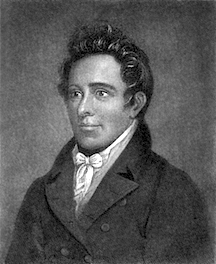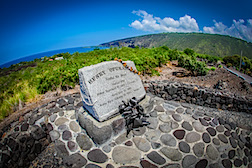Kahu's Mana‘o
The Sixth Sunday After Epiphany
ʻŌpūkahaʻia Sunday
Sunday, February 16, 2014
The Rev. Kealahou C. Alika
“The Heart of the Matter”
Matthew 5:21-37
ʻŌpūkakahaʻia was born in 1792, near Punaluʻu, on the island of Hawaiʻi. His mother Kumuola was connected to chiefs and chiefesses of district of Kaʻu.
At a time when a caesarian delivery was unknown, ʻŌpūkakahaʻia was surgically removed from his mother at the time of his birth. In the process his mother died.
What many saw as unusual occurrence resulted in the commemorative name that was given - ʻŌpūkakahaʻia - which means “stomach cut open.” He was raised by his father and foster mother.
 When ʻŌpūkakahaʻia reached the age of twelve, a war broke out among the chiefs. His parents were killed before his eyes. He and his younger brother who was three years old survived.
When ʻŌpūkakahaʻia reached the age of twelve, a war broke out among the chiefs. His parents were killed before his eyes. He and his younger brother who was three years old survived.
Hoping to save his brother from the tragedy which befell his parents, he grabbed his little sibling and placed him upon his back and ran from the enemy. However, he was quickly found by those chasing after them and his brother was killed.
He was taken away to district of Kohala to the north of Kaʻu and far from Punaluʻu. While living there he met his mother’s brother who brought him to the district of Kona. He was to spend his teenage years at Napoʻopoʻo, on the shores of Kealakekua Bay, under the tutelage of his uncle, a skilled kahuna or priest who was taught by the High Priest Hewahewa at Hikiau heiau.
In 1809, ʻŌpūkakahaʻia saw the ship called the Triumph sail into the Kealakekua Bay. He dove into the waters of bay, boarded the ship and became a seaman at the age of 17. His journey would take him to China and the West Indies and finally to the American port at New Haven, Connecticut in 1810.
He was taken under the care of Timothy Dwight, president of Yale University and a Congregational minister. While in Connecticut, ʻŌpūkakahaʻia attended Andover Theological Seminary and mastered English, Greek and Hebrew and it was while he was there that he became a convert to Christianity.
In 1817 a missionary school was built by the American Board of Commissioners for Foreign Missions in Cornwall, Connecticut. ʻŌpūkakahaʻia began lecturing throughout New England. Many became aware that it was his heart’s desire to return home to Hawaiʻi to share the good news of his new-found faith.
When he died in a typhoid epidemic on February 17, 1818, his dream of returning to Hawaiʻi would be fulfilled by others who would make the long journey in the following years. In 1819 the first mission company set sail from Boston and arrived in Kailua, Kona in 1820. In the three decades that were to follow more than 100 Congregational missionaries, inspired by the story of ʻŌpūkakahaʻia’s life, would make the journey to our islands.
I’ve often wondered how ʻŌpūkakahaʻia felt the day he saw his parents and brother killed before his eyes. I imagine the trauma of that day was so overwhelming that he saw an opportunity for him to start a new life when the Triumph dropped anchor in Kealakekua Bay five years after their deaths.
The promise of a new life is what we find in our reading from The Gospel According to Matthew. We learn what it means to practice the higher righteousness mentioned in verse 20. In our reading this morning four antithetical statements are made by Jesus based on the formula, “You have heard that it was said . . . but I say to you.”
In each case there is an attempt to apply Jesus’ teachings to new and very real situations concerning anger, adultery, divorce, and the oaths or commitment we make to one another. It would be too much for us to go into detail for each situation but what can be said is all four focus on a common theme and that is the primary importance of personal relationships.
This is especially significant when we look at ʻŌpūkakahaʻia’s desire to start a new life. Whatever anger he may have felt against those who killed his parents and brother, Jesus stresses the urgency of reconciliation – of the need for ʻŌpūkakahaʻia to be reconciled to those responsible for their deaths.
Anger (vv. 21-26), adultery (vv.27-30), divorce (vv. 31-32), and speaking the truth (vv. 33-37) are not new to any of us. In each case there is the need for personal relationships to be reconciled, to be in balance.
That is something I learned when I was 12 years old as a boarding student on the island of Oʻahu. Whenever the weekends would come and we were able to go to a movie or a bowling alley or the beach, we would receive an allowance for the day by writing out checks that we would present to a teller at a campus window.
We were taught to reconcile, to make certain that our checkbooks were in balance. It was a helpful lesson to learn but I must confess to this day it is a practice that I continue to neglect.
In many ways balancing a checkbook is much, much easier to do then it is to find balance in our lives when things go awry – when we are consumed by anger or overwhelmed by broken promises of fidelity and trust. I imagine ʻŌpūkakahaʻiaʻs anger, pain, sorrow and despair over the deaths of his parents and brother troubled him for many, many years.
I also imagine that in time he came to appreciate the words of the Apostle Paul who wrote: “From now on . . . we regard no one from a human point of view; even though we once knew Christ from a human point of view, we know him no longer in that way. So if anyone is in Christ, there is a new creation: everything old has passed away; see, everything has become new!”
“All this is from God, who reconciled us to himself through Christ, and has given us the ministry of reconciliation; that is, in Christ God was reconciling the world to himself, not counting their trespasses against them, and entrusting the message of reconciliation to us. So we are ambassadors for Christ, since God is making his appeal through us; we entreat you on behalf of Christ, be reconciled to God.” (2 Corinthians 5:16-20)
 ʻŌpūkakahaʻia was that ambassador to those whom he met in a land far from our own. Although he was not able to return home to Hawaiʻi, it was his life that inspired others to come.
ʻŌpūkakahaʻia was that ambassador to those whom he met in a land far from our own. Although he was not able to return home to Hawaiʻi, it was his life that inspired others to come.
I have always felt a great affinity with ʻŌpūkakahaʻia. I suppose some of that has to do with having been born in Kealakekua and knowing we were both from Kona. I suppose some of that has to do with having stepped into this pulpit for the first time on Sunday, February 17th twenty three years ago on the 173rd anniversary of his death.
I suppose some of it has to do with how he came to be named ʻŌpūkakahaʻia and of how the names of places begin to take on a significance of their own. Kealakekua means “the pathway to God.” That he ended his journey in a place called New Haven hardly seems coincidental.
The ministry of reconciliation had been given to ʻŌpūkakahaʻia. That message was entrusted to him. It was a message he sought to share with others.
May we be faithful in our ministry of reconciliation as ʻŌpūkakahaʻia was faithful in his. Thanks be to God. Amen.
